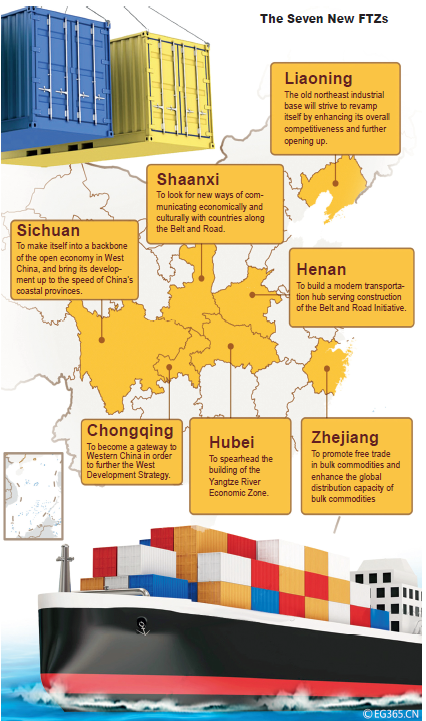Free Trade Zones Flourish
China Today by LAN GUOQING, January 23, 2017 Adjust font size:
THE Chinese government recently announced its intention to set up seven new pilot Free Trade Zones (FTZs) in Liaoning, Zhejiang, Henan, Hubei, Sichuan and Shaanxi provinces, as well as Chongqing Municipality. The unveiling of the expansion of FTZs happened on August 31, 2016, just three days before the opening of the G20 Hangzhou Summit.
It seems that the timing is perfect. The G20 Summit pools the most developed and promising economies in the world, making itself a highly influential group of nations. The announcement shows China’s desire to draw global attention to its continuation of the reform and opening-up policy and its market-oriented development mode. China will keep promoting free trade and renovate existing trading rules and systems according to international experience.
Meanwhile, the timely announcement will help attract the participation of world’s top-notch technology, talent, capital and enterprises. It’ll also, to a large extent, tap into the quality resources of China’s inland cities and steer its economy into the fast lane.
Sun Yuanxin, deputy dean of the Free Trade Zone Institute at Shanghai University of Finance and Economics (SUFE), said that the new FTZs and open economy experimental areas jointly serve as an indication of China’s determination to further open up its economy. From the layout of the seven FTZs and the 12 open economy experimental areas, we can see that reform is underway, aimed at building an all-around open economy during the 13th Five-Year Plan period from 2016 to 2020.
Individual Characteristics
Each of the seven new FTZs has their own development modes and targets. To be more specific:
Northeast China’s Liaoning Province will mainly implement central government’s request to quicken the pace of its reform in market orientation and to speed up its structural adjustment. The old northeast industrial base will strive to revamp itself by enhancing its overall competitiveness and by further opening up.
Southeast China’s Zhejiang Province will mainly explore how to build the Zhoushan Free Trade Port Zone, to promote free trade in bulk commodities and to enhance the global distribution capacity of bulk commodities.
Central China’s Henan Province will focus on quickening the pace of building a multi-modal traffic system and modern logistics system. The province aims to become a transportation junction of the country, and also serve for the construction of the Belt and Road Initiative.
Central China’s Hubei Province is aiming to conduct proper industrial transfer in central China and build bases for strategic emerging and high-tech industries. This will spearhead the Rise of the Central Region plan and the building of the Yangtze River Economic Zone.
Chongqing, the only municipality directly under the central government in West China, is concentrating on making itself into a strategic hub, connecting the landlocked western part of China to the outside world. It will also expedite opening-up to become a gateway to western China, in order to further the West Development strategy.
Southwest China’s Sichuan Province is aiming to implement the central government’s request on expediting the opening-up and make itself into a backbone of the open economy strategy in the West China, to bring its development up to the speed of China’s coastal provinces.
Northwest China’s Shaanxi Province will work to become a center for inland reform and opening-up, explore the creation of a new economic model and to look for new ways of communicating economically and culturally with countries along the new Silk Road routes.

The expansion of FTZs is part of China’s national strategy. Their locations, the way they are implemented, what kind of characteristics they are endowed with and what reforming targets they aim to meet, are all chosen carefully with an eye on the country’s overall development.
We can tell from these seven FTZs and their pilot projects that the provinces or cities they are in all occupy a strategic position in their respective areas, therefore aiding their various functions of economic development – facilitating further opening-up, attracting foreign investment, exploring new routes to reform and transformation modes, and improving the competitiveness of leading local industries. All of these are expected to form new models for regional strategic planning and reforms.